In early 1974, Bachman-Turner Overdrive released one of their most famous hits: Takin’ Care of Business. That’s the theme of the business coupe made by several manufacturers, just gettin’ it done and takin’ care of business. This 1948 Dodge D-24 DeLuxe business coupe, or 3-passenger coupe, looks like it can take care of business. It can be found here on eBay in Ladonia, Texas and the seller has a buy-it-now price of $10,500 listed or you can make an offer. Thanks to Ikey H. for this tip!
I have wanted a business coupe from any manufacturer for decades, why I haven’t owned one yet is beyond my scope of comprehension. They’re sometimes called a three-passenger coupe or a businessman’s coupe and, generally, they’re characterized as having no back seat, no rear side windows, and a huge trunk for holding the goods that a traveling salesman would carry. As with almost everything, there doesn’t appear to be a definitive answer to just what a business coupe is. Some people define them as cars with a shorter passenger compartment and a long trunk, but they can still have a backseat. I’m sticking with the original definition of a car with typically no rear side windows, no rear seat, and a big trunk.
Speaking of trunk, now that’s a trunk! It’s probably big enough to sleep in, I wonder if a Pontiac Aztek tent would fit on the back of this car… The later 1949 Dodges were redesigned and they looked more modern than this 1948 car did, but that’s one of the biggest charms of the vintage car hobby, isn’t it? Owning, tinkering with, and driving something that looks old. Hagerty is at $8,200 for a #3 good condition car so there may be some bargaining room on this one, at least value-wise if not owner’s-perception-of-value-wise.
This car looks really good, other than showing a bit of rust bubbling under what I believe may be faded LaPlata blue paint. The dash is a work of art and it seems like it was almost designed more for smoking than for listening to the radio, with the ashtray being on the right side and maybe easier to get at. Although, once you set the radio station you can go back to your unfiltered Lucky Strikes. They say that it just made an 80-mile trip with no problems at all, but the gas gauge doesn’t appear to be working.
The engine is Chrysler’s 230 cubic-inch L-head inline-six with 102 hp. The seller says that the car has been converted to a 12-volt system which will be a nice upgrade for the next owner. It runs and drives excellent, according to the seller, and they even have period-appropriate add-on pieces such as rear fender skirts and a sun visor. Are there any business coupe fans out there? How about Bachman-Turner Overdrive fans?






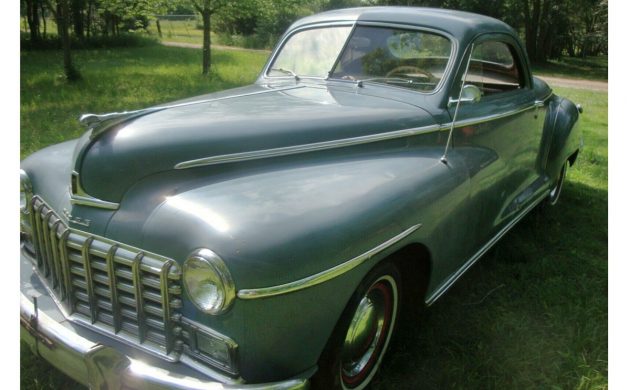
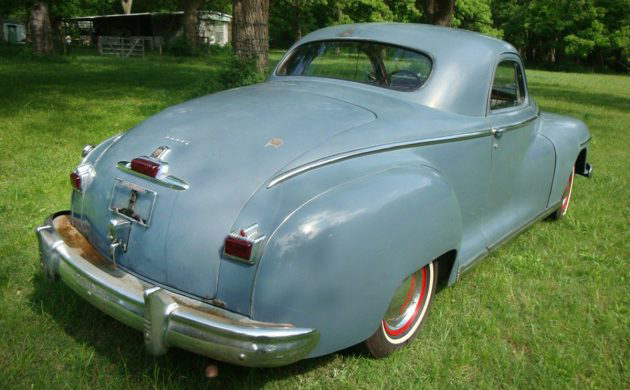
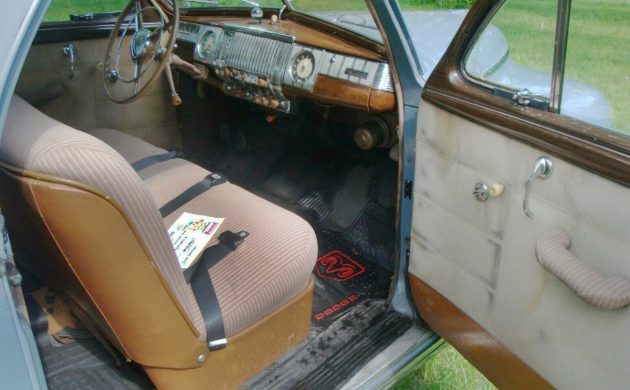
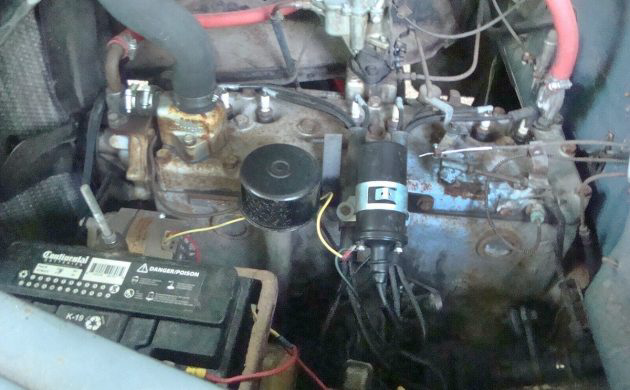
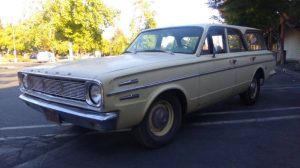
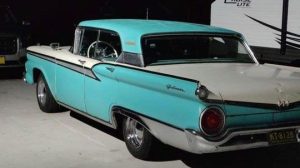
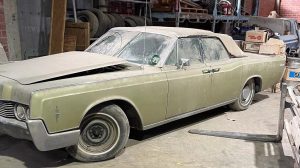
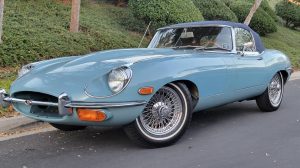


Awesome looking car.
Love BTO and this car. Rock On.
I could Let It Roll down the highway in this Dodge.
Sometimes simplicity is the best style of them all. The exterior has the proper amount of trim that keeps the lines fresh and avoids looking gaudy. The interior is the same, utilitarian and well balanced. Let It Ride ( great intro). Very nice car.
Coupe/sedan/landUlet/ etc. all of these classifications came from the early days of motoring in Europe and are based on the zillion different kinds of coaches available. A “Berlin” was like a stagecoach, with two seats inside facing each other. A “Sedan” had at least 2 forward facing seats. A “coupe” was a clipped sedan, with one seat facing forward. The 1920s were the heyday of configurations in the luxury field; look up Cadilllacs Byzantine line up; you can’t tell some models from others. By mid century you had the roadster, one forward facing seat, convertible; then the coupe, a roadster with a roof and 3 windows. Not very practical for families, so some had a rear kiddie seat and 5 windows. Then two door sedans, 4 door sedans. If the 4 door was convertible, then it was a “touring car”. 2 door sedan convertibles never really got their own name, except “convertible “. Then, in the early 50s, came the “hardtop” because it was a 2 door pillar less sedan. They also had 4 door hardtop sedans. Hardtops were killed in the early 70s as unsafe. In the midst of all of this were the manufacturers renaming everything, such as Club coupe, touring sedan, club sedan, touring coupe, etc. and the Tbird roadster, which had a cover over the back seat. And then there was the “Country Club.” Nash’s term for a hardtop.
These were always a real nice car. A business coupe is a rare beast compared to a good ol’ sedan so I hope that the buyer will keep this one unique. Used to see a lot of Dodges running the Fluid Drive. Living on the border we saw lots of real Dodges and lots of ‘Plydges,’ (or are they a ‘Dodyth?’) from the Canadian side which were also real good cars. It seems that as time goes on, you see more of them.
They are called Plodges. I had a 66 Plodge & a 64 Cheviac (Pontiac front & rear, Chev in the middle including a 283 & Powerglide. My uncle had a 59 Monarch 4 door hardtop. All kinds of weird & wonderful variations up here in the Great White North.
Dat grill doh… omg beautiful..one of these coming up on your six would cause a accident
What fun! Scrolled right past basket case muscle cars, decent rides all, and my cursor found this car perfect.
Not Fragile.
beautiful car. I’d drive it just the way it is.
Funniest thing I have ever seen on one of these cars at a car show is a sign at the very rear of the cavernous open trunk that said “APARTMENT FOR RENT”. Said it all.
Nobody mentioned the Fluid Drive. Each gear had an upper and lower range. Normally, the gear lever was pushed down, after pushing in the clutch. Releasing the clutch, the car would move forward. When some speed was reached, letting up on the gas allowed the trans to shift. Starting with the shift lever up in low gear, doing the same would give you 2 speeds forward in low range. You could stop with the clutch engaged without killing the engine.
Performance was dismal at best.
I don’t know if there was any real difference but my 40 olds was referred to as a doctor’s coupe. No backseat, spare tire behind the passenger, a storage space behind the driver seat, and a large trunk with a second spare tire. Used that as a daily driver for two years before I had any common sense. Great 6 cylinder and first-year automatic. Wish I still had it!!
You need to drive one of these cars to say if you like ,love, or hate
That year Dodge’s Fluid Drive was merely a fluid coupling hooked to the standard 3 Spd transmission. Only the DeSotos and Chryslers in 1948 had the semi-automatic 4 Spd transmission. But in the Dodge you could easily start in 2nd gear from a full stop. And as someone said, it’s impossible to stall the engine.
City taxi drivers loved them. Drive all day in second using only brake and gas pedals. The semi-automatic was a four speed with electric shift for 1-2 and 3-4. My mother used “D”, starting in 3rd, for the fifteen years she drove our ’53 Chrysler. It finally got a torque converter for ’53, the last year.
Huge trunk on this car!! Love the way the back of this car is so fattttt!!!! Just awesome!!!
Love a Coupe.
City taxi drivers loved them. Drive all day in second using only brake and gas pedals. The semi-automatic was a four speed with electric shift for 1-2 and 3-4. My mother used “D”, starting in 3rd, for the fifteen years she drove our ’53 Chrysler. It finally got a torque converter for ’53, the last year.